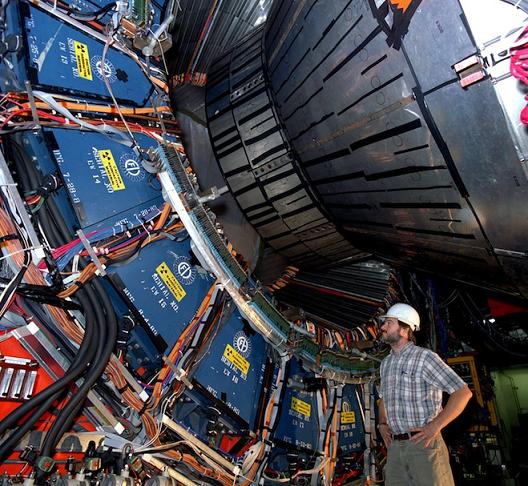|
Physicists Pinpoint W Boson, Narrow Search for Higgs

Scientists have produced the most precise measurement of a
fundamental particle called the W boson. It will help them
search for the elusive Higgs boson, the discovery of which would
be an epoch-making event.
The W boson’s new mass is 80.387 giga electron volts, or GeV,
plus or minus 0.019 GeV. (Scientists often give a particle’s
mass in units of energy because, according Einstein’s famous
E=MC˛ equation, the two are interchangeable.) The most precise
previous measurement had an uncertainty of about 0.060 GeV.
At the subatomic scale, such little differences are immense.
The new result is “exquisite” and places the uncertainty “in
another category with respect to the past results,” wrote
physicist Tommaso Dorigo in
his blog. The finding was presented Feb. 23 at the Fermi
National Accelerator Laboratory in
Illinois.
Researchers with the CDF
collaboration at
Fermilab produced the estimate using data from the now-closed
Tevatron, formerly the world’s
premier particle accelerator, where measurements of
collisions between protons and antiprotons fired around a
4-mile-long track provide insight into the subatomic
world. Though CERN’s Large
Hadron Collider has
eclipsed the Tevatron, the result shows that the U.S. lab still
has a few tricks up its sleeve.
The W boson, along with its counterpart the Z boson, are
responsible for carrying the weak
force, much the same way that photons convey electromagnetic
force. Together with gravity and strong nuclear force, these
comprise the four fundamental forces of nature. The W boson’s
discovery in 1983 was a major success for the Standard
Model, developed by physicists to explain the interactions
of all subatomic particles and forces, and its mass is an
important input for many nuclear and astrophysical calculations.
It’s also intimately linked to two other subatomic particles:
the top quark, the heaviest of the six types of quarks, and the
Higgs boson. “If you know the mass of any two, you know the mass
of the third,” said physicist Rob Roser, co-spokesman for the
CDF collaboration.
'It's basically make it or
break it for the Standard Model.'
That potential extrapolation is crucial. While the Higgs boson
has been theoretically predicted to exist, and is believed integral
to the very essence of mass,
it hasn’t actually been spotted.
Last December, researchers at the Large Hadron Collider sawhints
of what may be the Higgs boson, and pegged its mass at about
125 GeV. The extra-precise measurement of the W boson fits with
this measurement of the Higgs. The result also means that
physicists shouldn’t expect to find the Higgs anywhere higher
than 145 GeV.
All eyes are now on this final sliver of energy where the Higgs
may be hiding, said physicist Ashutosh
Kotwal of Duke
University in North Carolina, who presented the latest results
from the CDF collaboration. If the Higgs turns up there, it will
confirm scientists’ theories. If it doesn’t, they will have to
start looking for new, more exotic ways to explain the universe.
“It’s basically make it or break it for the Standard Model,”
said Kotwal.
Though the Large Hadron Collider has progressed further in the
Higgs search, Fermilab scientists still hope to be part of the
discovery. Next
month they will
present their latest Tevatron data, which may include a Higgs
signal. And even if Fermilab doesn’t find the Higgs themselves,
the LHC may never be able to measure the W boson with comparable
precision. Its mass may be one of the Tevatron’s great legacy
calculations, said Roser.
In another three or four years, the CDF collaboration will use
the remaining Tevatron data to produce a final estimate, which
could go down in history as the most precise W boson measurement
ever.
Image: Fermilab physicist
Pat Lukens stands in front of the CDF detector. CDF/Fermilab
Source: Wired
Scienice
1 2 3 4 5 6 7 8 9 10 Newest
articles
|
